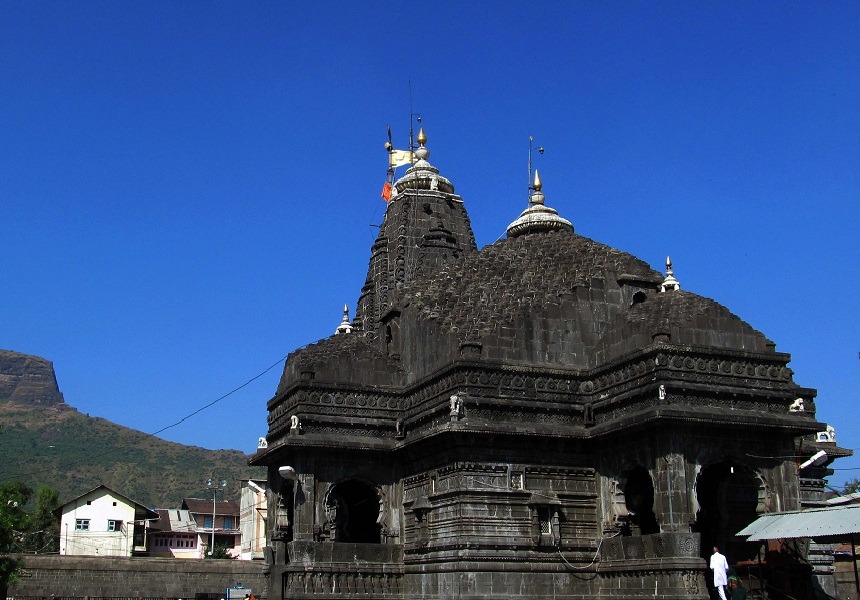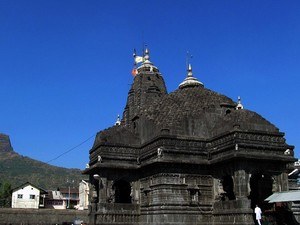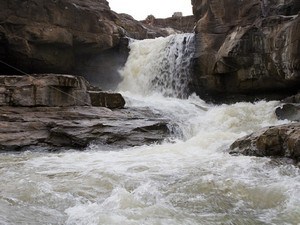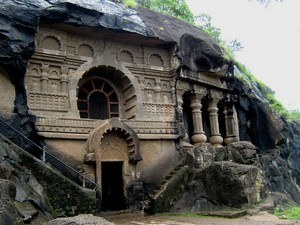Trimbakeshwar / Tryambakeswar, Nashik - Timings, Festivals, History, Darshan, Pooja Timings
Photo Credit: Flickr
 India | Maharashtra | Nashik
India | Maharashtra | Nashik
 #6 of 21 Places to Visit in Nashik
#6 of 21 Places to Visit in Nashik
 Distance (From Nashik CBS Bus Station): 28 Kms
Distance (From Nashik CBS Bus Station): 28 Kms
 Trip Duration (Including Travel): 3-4 Hours
Trip Duration (Including Travel): 3-4 Hours
 Transportation Options: Bus / Cab
Transportation Options: Bus / Cab
 Travel Tips: None
Travel Tips: None
About Trimbakeshwar/Tryambakeswar Temple
At a distance of 28 Km from Nashik, Trimbakeshwar or Tryambakeswar is a small pilgrimage town situated along the banks of the Godavari River, at the base of the Brahmagiri Mountains in the Nasik district of Maharashtra. The town is renowned for the Trimbakeshwar Temple, one of the twelve Jyotirlinga temples dedicated to Lord Shiva, which carries significant religious and mythological importance. It is one of the popular places of pilgrimage sites in Maharashtra, and among the most famous places to visit near Nashik. The sacred Godavari River has its source in the vicinity of Trimbak.
History & Mythology of Trimbakeshwar/Tryambakeswar Temple
Trimbakeshwar Temple was constructed by Sri Nana Saheb Peshwa between 1755 and 1786 AD and is regarded as among the most sacred pilgrimage sites near Mumbai. This temple is referenced in the revered Mrityunjaya Mantra, which is believed to confer immortality and longevity. According to tradition, the sage Gautama Rishi and his wife Ahalya lived in the Brahmagiri Hills, renowned for their devoutness. Their unwavering faith was so profound that their hermitage was continuously supplied with food, even during times of severe famine. However, envious sages deceived Gautama, leading him to unwittingly commit the sin of cow slaughter. To atone for this transgression, Gautama Rishi undertook intense penance to Lord Shiva. Pleased by his dedication, Lord Shiva granted him a boon, resulting in the release of the sacred Ganga River, which became known as the Godavari River. In commemoration of this event, Lord Shiva manifested as a three-faced Jyotirlinga, representing Brahma, Vishnu, and Shiva, thus establishing Trimbakeshwar as one of the most distinctive Jyotirlingas in India.
Architecture of Trimbakeshwar/Tryambakeswar Temple
Designed in classic Nagara style of architecture, the temple is built with black granite, and is enclosed in a spacious courtyard. The sanctum is crowned with a graceful tower, embellished with a giant amalaka and a golden kalasha. In front of the garbagriha and the antarala is a mandap with doors on all four sides. The entire structure is ornamented with sculptural work featuring running scrolls, floral designs, and figures of gods, yakshas, humans, and animals.
The sanctum internally a square and externally a stellar structure houses the presiding deity of the temple Lord Shiva in the form of a small lingam who is seen in a depression on the floor of the sanctum. The extraordinary feature of the Jyotirlinga located here is its three faces embodying Lord Brahma, Lord Vishnu, and Lord Shiva. A crown studded with precious stones rests on top of this Linga, which is said to be from the age of Pandavas. This crown is decorated with various precious stones like emeralds, diamonds, and many other varieties. The crown is displayed every Monday from 4 PM - 5 PM.
Kushavarta, a sacred pond in the temple premises is the source of the Godavari River, the longest river in peninsular India. As per legends, Trimbakeshwar was the place of 'Tri-Sandhya Gayatri' where Lord Ganesh was born. Gangadwar, Brahmagiri, Caves of 108 Shivalingams, Parashuram temple, Bilwa Tirtha, Gautama Tirtha, Indra Tirtha, and Ahilya Sangam Tirtha are some other places that can be visited in Trimbakeshwar. It also has several ashrams devoted to Ashtanga Yoga, the Hindu art of living. It is also famous for lots of religious rituals such as Narayan Nagbali, Kalsarpa Shanti, Tripindi Vidhi, etc. Of these, the Narayan Nagbali ritual is performed only at Trimbakeshwar.
Festivals of Trimbakeshwar/Tryambakeswar Temple
Trimbakeshwar Temple is renowned for its magnificent festivals that draw thousands of worshippers. The most prominent celebration is Maha Shivaratri, occurring in February or March, during which all-night prayers, processions, and unique rituals honoring Lord Shiva take place. Additionally, the Simhasta Kumbh Mela, celebrated every 12 years, turns Trimbak into a spiritual center, attracting millions of pilgrims who come to bathe in the sacred Godavari River. Other notable festivals, such as Shravan Maas, Nag Panchami, and Kartik Purnima, further enhance the temple's lively atmosphere.
Trimbakeshwar/Tryambakeswar Temple Dress Code & Other Restrictions
When planning a visit to the Tryambakeswar Temple, it is recommended to adhere to modest clothing that covers your upper arms and legs as a sign of respect. Men are encouraged to wear a dhoti or pajama paired with an upper garment, as well as formal trousers and shirts. Men may need to remove their shirts and cover themselves with a cloth. Women may opt for a saree, half saree, or chudidhars. It is advisable to refrain from wearing contemporary attire such as mini-skirts, shorts, and sleeveless tops while on the temple grounds.
Non-Hindus are welcome to explore the temple complex and appreciate its architectural beauty; however, access to the sanctum sanctorum may be restricted.
Trimbakeshwar/Tryambakeswar Temple Timings
Monday: 5:30 AM - 9 PM
Tuesday: 5:30 AM - 9 PM
Wednesday: 5:30 AM - 9 PM
Thursday: 5:30 AM - 9 PM
Friday: 5:30 AM - 9 PM
Saturday: 5:30 AM - 9 PM
Sunday: 5:30 AM - 9 PM
Trimbakeshwar/Tryambakeswar Temple Entry Fee
General Entry is Free
Special Darshan available for Rs. 200
Best Time to Visit Trimbakeshwar/Tryambakeswar Temple
The ideal time to visit Trimbakeshwar Temple is from October to March, when the climate is enjoyable, ensuring a comfortable experience at the temple. During the monsoon season, which lasts from June to September, the area transforms into a verdant paradise, offering stunning views of the Brahmagiri Hills. For those seeking to experience the temple at its most spiritually significant moments, attending Maha Shivaratri or the Kumbh Mela is essential. These festivals present a chance to see the temple in its most vibrant and dynamic state. Conversely, summer is not an advisable time for a visit, as temperatures can reach up to 45 degrees, resulting in uncomfortable heat and humidity.
How to Reach Trimbakeshwar/Tryambakeswar Temple
Mumbai Airport is the nearest airport which is about 170 km from Trimbakeshwar Temple. About 28 Km away, Nashik Road Railway Station is the nearest rail head to Trimbakeshwar which is well connected by train with all major towns and cities in India, including Mumbai, Delhi, Kolkata, Chennai, Hyderabad, and Bangalore. Nashik is well connected by bus with Indore, Pune, Aurangabad, Shirdi, Mumbai, Nanded, Nagpur, Akola, Hyderabad, Latur, Satara, Kolhapur, Ratnagiri, Ahmednagar, Ahmedabad, Solapur, Surat, Ahmadabad, Vadodara, etc. The temple is also well-connected by road, with state transport buses and private taxis operating regularly from Nashik and other nearby cities.




















